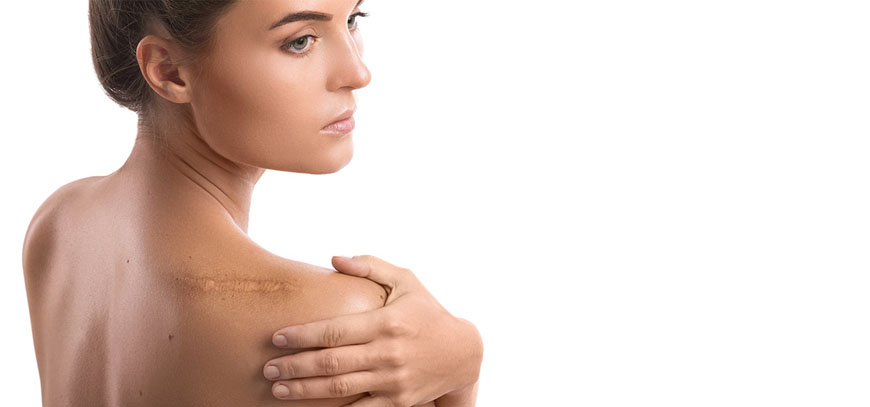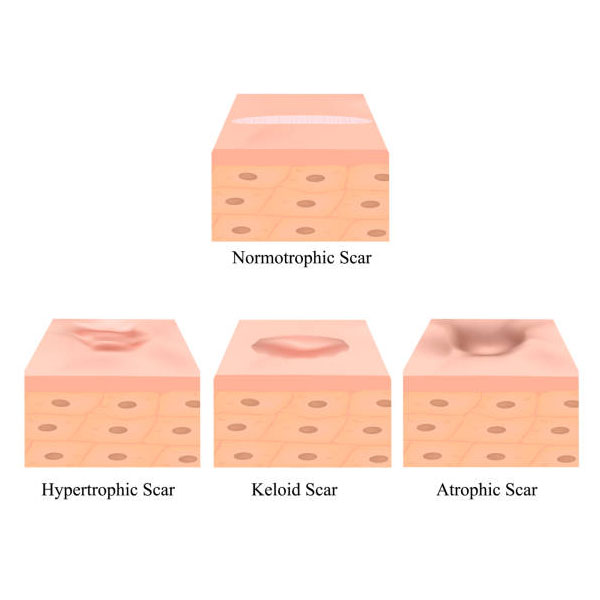Scars and Kelloids

Keloids can be a source of discomfort, itchiness, or pain, prompting those affected to seek suitable treatment options. Additionally, when these raised scar tissues form over joints like the shoulder, they may hinder movement and cause further inconvenience. Beyond the physical aspects, many individuals also express dissatisfaction with the appearance of keloids.
What are Keloids?

The development of keloid scars is a natural protective response by the skin to injuries, including burns or acne scars. While some keloids may gradually flatten over time, certain individuals may opt for surgical removal if they prefer a different approach to managing these scars.
How is it diagnosed?
Diagnosing a keloid is typically done by visual examination, and a skilled dermatologist can identify it through this process.
However, there are instances where another skin condition might resemble a keloid, causing confusion. For instance, an allergic skin reaction to certain metals like gold in earrings can lead to swelling that mimics the appearance of a keloid.
In such cases, a dermatologist may decide to perform a skin biopsy to accurately determine the underlying condition. This is a straightforward procedure that can be conveniently carried out during your visit to the dermatologist's office, and it is conducted with the patient remaining awake throughout.
During the skin biopsy, the dermatologist numbs the area, then extracts a small sample of skin for microscopic examination. The removed skin is sent to a medical lab, where a doctor will carefully analyse it and provide a detailed report to the dermatologist, explaining the findings observed under the microscope.
With a definitive diagnosis in hand, your dermatologist can create a personalized treatment plan tailored to your specific needs, ensuring that you receive the most appropriate and effective care for your condition, be it a keloid or another skin issue.
How are keloids treated?

Keloid scar treatments encompass a range of approaches, and the most suitable option, or a combination thereof, depends on everyone’s unique situation. Despite successful flattening or removal, keloids have the potential to grow back, and sometimes they can even reappear larger than before. Additionally, new keloids may develop over time.
- For newer keloids, the initial treatment option may involve using compression dressings made from stretchy materials to apply pressure on the wound as it heals. This technique is also employed after keloid removal surgery, aiming to reduce or prevent scarring. However, wearing these dressings for 12 to 24 hours a day over 4 to 6 months can be uncomfortable.
- To ease itchiness, a prescription strength corticosteroid cream can be applied to the affected area. Smaller keloids might be treated by injecting cortisone or other steroids to reduce their thickness. Multiple monthly injections, possibly up to six months, may be required to achieve scar flattening, but this method could lead to side effects like skin thinning, spider veins, and changes in skin colour.
- Freezing keloids with liquid nitrogen (cryotherapy) is another option for reducing or removing smaller keloids. However, multiple treatments may be necessary, and side effects could include blistering, pain, and changes in skin colour.
- Larger keloids can be flattened using pulsed-dye laser sessions, which have also shown effectiveness in easing itchiness and causing keloids to fade. Laser therapy is typically delivered over several sessions with intervals of 4 to 8 weeks, and it can be combined with cortisone injections. However, certain side effects, more common in individuals with darker skin, may include changes in skin pigmentation, blistering, and crusting.
- Radiation therapy using low-level X-ray radiation, either alone or after surgical keloid removal, can help shrink or minimize scar tissue. Repeat treatments might be necessary, but potential side effects include skin complications and, in the long term, a risk of cancer.
When other treatments have not yielded the desired results, surgical removal of keloids might be recommended, often in combination with other methods. However, it is important to note that surgery alone has a high recurrence rate ranging from 45% to 100%.
Considering the wide array of available treatment options, consulting with a healthcare professional is crucial to determine the most appropriate and effective approach for managing keloid scars in each specific case.
What is the cost of scars and keloids removal treatment?
The expenses associated with keloid facial scar removal can exhibit variation based on several factors, including the chosen technique, the surgeon's fees, and the clinic's location. Typically, surgical removal tends to be the costliest procedure, with laser therapy, cryotherapy, and steroid injections following in descending order. In India, the cost of keloid scar removal procedures can span from Rs. 5,000 to Rs. 1,00,000, contingent on the specific method employed for treatment.
Frequently Asked Questions:
The level of discomfort experienced during keloid scar removal procedures can vary based on the technique used. Surgical removal and cryotherapy may cause some discomfort, which can be managed with local anesthesia or pain medication. Laser therapy and steroid injections are generally less painful, with patients reporting minimal discomfort during the procedures.
Yes, there are non-invasive treatments available for keloid scars. Laser therapy and steroid injections are considered non-invasive options that can help flatten and reduce the appearance of keloids. These treatments typically require minimal downtime and can be performed in outpatient settings.
The time required to see noticeable results from keloid scar removal treatments can vary depending on the individual and the chosen method. Steroid injections may take several months of regular treatments before significant improvement is observed. Laser therapy sessions are usually spaced weeks apart, and visible changes can be seen over the course of multiple sessions.
While keloid removal treatments can significantly reduce the size and appearance of keloid scars, complete eradication may not always be possible. Keloids tend to recur, and their response to treatment varies from person to person. However, with appropriate and timely interventions, keloids can be managed effectively to minimize their impact.
Yes, post-treatment care is crucial for optimal results after keloid scar removal. Depending on the method used, your healthcare provider may recommend keeping the treated area clean and protected from sun exposure. Following any prescribed wound care instructions and attending follow-up appointments as advised by your doctor can aid in the healing process and improve treatment outcomes.
Procedure Time:
- 2-5 hours
Full Recovery:
- 6 weeks
Anaesthetic:
• General
Back to work:
• After 2 weeks
Duration of results:
• Permanent
Results:
• Noticeable within 2 weeks
Temporary risks & complications:
• May include soreness, bleeding, persistent pain, and infection
• *Individual results and reactions may vary.
